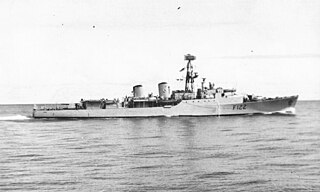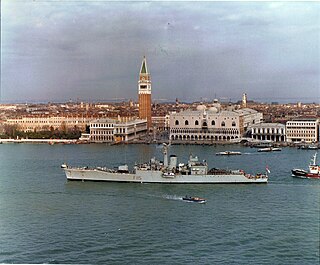Description
Falmouth displaced 2,150 long tons (2,180 t) at normal load and 2,560 long tons (2,600 t) at deep load. The ship had an overall length of 370 feet (112.8 m), a beam of 41 feet (12.5 m) and a draught of 17 feet (5.2 m) at deep load. She was powered by a pair of geared steam turbines, each driving one shaft, which developed a total of 30,000 shaft horsepower (22,000 kW) and gave a maximum speed of 29 knots (54 km/h; 33 mph). Steam for the turbines was provided by a pair of Babcock & Wilcox boilers. Falmouth had a range of 4,500 nautical miles (8,300 km; 5,200 mi) at 12 knots (22 km/h; 14 mph). The ship's complement was 200–35 officers and ratings. [1]
The ship mounted a pair of 4.5-inch (114 mm) Mk 6 guns in a single twin-gun turret forward. Her secondary armament consisted of a twin-gun STAAG mount for the Bofors 40-millimetre (2 in) anti-aircraft gun aft. Falmouth mounted two triple-barrelled mounts for the Limbo anti-submarine mortar. The ship carried eight fixed torpedo tubes and two twin-tube rotating mounts for 21-inch (533 mm) torpedoes. [1] The Rothesay-class ships were equipped with a Type 170 sonar for the Limbo as well as a general-purpose Type 174 sonar. They were fitted with a Type 293Q target-indication radar and a Type 277Q surface-search radar. [2]
Construction and career
Falmouth was laid down on 23 November 1957 by Swan Hunter & Wigham Richardson, launched on 15 December 1959 and was completed on 25 July 1961. [3]
In August 1961 Falmouth joined the 20th Frigate Squadron based at Londonderry Port, Northern Ireland. [4] On 5 December that year, Falmouth collided with the oiler RFA Tideflow in Lyme Bay and was badly damaged. [5] [6] From December 1963, Falmouth served as leader of the 30th Frigate Squadron. [7] The 30th Flotilla, including Falmouth, served as part of the Far East Fleet from September 1964 to December 1964, and again from June 1965 until December that year. [8] Falmouth took part in the Beira Patrol, a naval blockade enforcing an oil embargo against Rhodesia, patrolling off Mombasa in January 1967. [9]
From August 1968 to 6 January 1971, Falmouth was refitted at Portsmouth Dockyard, being fitted with a hangar and flight deck to allow operation of a single Westland Wasp helicopter, while a Seacat launcher was fitted on top of the hangar. One of the Limbo mortars and the Bofors guns were removed in compensation. [4] [10] [11]
On the evening of 6 May 1976, after the outcome of the Third Cod War had already been decided, the Icelandic gunboat V/s Týr was trying to cut the nets of the fishing trawler Carlisle, when Captain Gerald Plumer of Falmouth ordered it rammed. Falmouth rammed the Týr at the speed of 22+ knots (41+ km/h), almost capsizing her. Týr did not sink and managed to cut the nets of Carlisle, after which the Falmouth rammed it again. The Týr was heavily damaged and found herself propelled by only a single screw and pursued by the tug-boat Statesman. As a response Captain Guðmundur Kjærnested gave orders to man Týr's guns to deter any further ramming. [12] Falmouth also sustained serious structural damage on her bow during the incident, [13] and had to enter dry dock at Portsmouth for repairs. [14]
In January 1977, when the United Kingdom enlarged its Exclusive economic zone to 200 nautical miles (370 km), Falmouth was deployed in the North Sea, protecting fishing stocks and oil fields. [15]
Falmouth left active service in 1980, when she was transferred to the Standby Squadron at Chatham, and by early 1982 she was being considered for disposal as a result of the 1981 Defence White Paper, which proposed cuts in the Royal Navy's surface fleet. [16] [10] Argentina's invasion of the Falkland Islands in April 1982 changed these plans, and Falmouth was given a refit and returned to active duty, although she did not take part in the Falklands War. [10] Falmouth carried out a patrol in the South Atlantic from May 1983, returning to Britain in September that year. In March 1984, she was deployed to the Middle and Far East, returning home in August that year. [4]
Falmouth was laid up as a stationary training ship at HMS Sultan in December that year, and was scrapped in Spain from 4 May 1989. [16] [17]

HMS Andromeda was a Leander-class frigate of the Royal Navy. She was built at HM Dockyard Portsmouth. She was launched on 24 May 1967 and commissioned into the Royal Navy on 2 December 1968. She took part in the Falklands War. She was sold to India in 1995, for use as a training ship, being renamed INS Krishna. She was finally decommissioned in May 2012.

HMS Danae was a Leander-class frigate of the Royal Navy. She was, like the rest of the class, named after a figure of mythology. Danae was built by Devonport Dockyard. She was launched on 31 October 1965 and commissioned on 10 October 1967.

HMS Tartar (F133) was a Tribal-class frigate of the Royal Navy (RN). She was named after the Tartar people, most of whom were located in Asia and Eastern Europe. She was sold to the Indonesian Navy in 1984 as KRI Hasanuddin (333).

HMS Gurkha (F122) was a Tribal-class frigate of the Royal Navy. She was named after an ethnic group located in Nepal, and who continue to serve in the British Army. She was sold to the Indonesian Navy in 1984 and renamed KRI Wilhelmus Zakarias Yohannes (332).

HMS Yarmouth was the first modified Type 12 frigate of the Rothesay class to enter service with the Royal Navy.

The ships of the F120 Köln class of frigates were the first major warships built in Germany after World War II.

The Chamsuri class are patrol boats originally constructed for and operated by the Republic of Korea Navy. They first entered service in 1979, and they have since seen service with five other navies, of which the Philippine Navy is currently the largest import user. These boats were built by the Korea Tacoma, and Korea SB & Eng. Masan shipyards. In Korea, the Chamsuri-class boats are being retired and replaced by Gumdoksuri-class patrol vessels.

USS Downes (DE-1070/FF-1070) was the 19th in the series of the Knox-class frigates. She was the third ship to be named for Commodore John Downes

HMS Blackwood was the name ship of her class of second-rate anti-submarine frigates built for the Royal Navy in the 1950s.

HMS Grafton was one of a dozen Blackwood-class frigate of second-rate anti-submarine frigates built for the Royal Navy in the 1950s.

HMS Keppel (F85) was one of a dozen Blackwood-class frigate of second-rate anti-submarine frigates built for the Royal Navy in the 1950s. She was named for Augustus Keppel, who served during the Seven Years' War and was admiral of the Western Squadron during the American War of Independence.

HMS Murray (F91) was one of a dozen Blackwood-class frigate of second-rate anti-submarine frigates built for the Royal Navy in the 1950s. She was named for George Murray, who served during the late 18th and early 19th centuries.

HMS Palliser (F94) was one of a dozen Blackwood class frigates of second-rate anti-submarine frigates built for the Royal Navy in the 1950s. She was named for Hugh Palliser, who served during the Seven Years' War and was First Naval Lord during the American War of Independence

HMS Pellew (F62) was one of a dozen Blackwood-class frigate of second-rate anti-submarine frigates built for the Royal Navy in the 1950s. She was named for Israel Pellew, who served during the French Revolutionary and Napoleonic Wars. He was brother to Edward Pellew, 1st Viscount Exmouth

HMS Rothesay was the lead ship of the Rothesay or Type 12M class of anti-submarine frigates of the British Royal Navy. She was commissioned in 1960 and scrapped in 1988.

HMS Berwick was a Rothesay- or Type 12I-class anti-submarine frigate of the British Royal Navy. She was built by Harland & Wolff and launched on 15 December 1959.

HMS Salisbury was a Salisbury-class or Type 61 aircraft direction frigate of the British Royal Navy. Completed in the late 1950s, Salisbury served through the 1960s and 1970s, participating in the Beira Patrol, blockading against Rhodesia and the confrontation with Iceland over fishing rights that was known as the Cod Wars. Salisbury became a harbour training ship in 1980, before being sunk as a target in 1985.

HMS Wrangler was one of eight W-class destroyers built for the Royal Navy during World War II. Completed in 1944, the ship spent most of the war in the Far East and escorted British aircraft carriers as their aircraft attacked targets in the occupied Dutch East Indies and in Japan itself. Wrangler was present in Tokyo Bay when the Japanese formally surrendered on 2 September 1945.

The Commandant Rivière class was a class of frigates built for the French Navy in the late 1950s and early 1960s. Labeled "aviso-escorteur", they were designed to perform the role of overseas patrol in peacetime and anti-submarine escort in wartime. This vessel class is named after the French Navy officer Henri Rivière (1827–1883).

HNLMS Tjerk Hiddes (F804) was a frigate of the Van Speijk class. The ship was in service with the Royal Netherlands Navy from 1967 to 1986. The ship's radio call sign was "PAVC". She was sold to the Indonesian Navy where the ship was renamed KRI Ahmad Yani (351).
This page is based on this
Wikipedia article Text is available under the
CC BY-SA 4.0 license; additional terms may apply.
Images, videos and audio are available under their respective licenses.




















